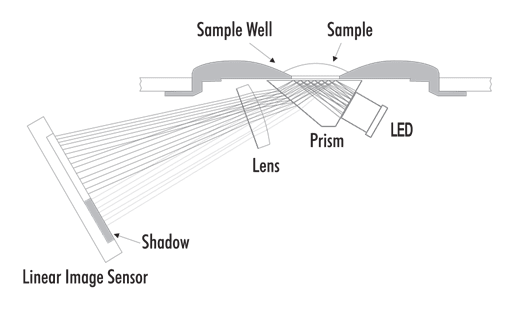
Environmental Monitoring of Nitrates and Other Water Quality Parameters: pH,
Environmental Monitoring of Nitrates and Other Water Quality Parameters: pH,...

Refractive index, also known as index of refraction, refers to the optical characteristic of a certain substance and the dissolved particles in it.
In other words, the refractive index measures the ratio of the speed of light in a vacuum to the speed of light in the substance of interest. As light travels through substances of different refractive characteristics or densities, it will bend or change direction.
Refractive index can be measured with the formula:
n = c / v
n being the index of refraction,
c being the speed of light in a vacuum or air
v being the speed of light in the media, such as water, olive oil, etc.

As light enters a material with a higher refractive index, the refraction angle will be smaller than the angle of incidence, resulting in the light being refracted towards the normal of the surface. The higher the refractive index, the closer the light will travel to the normal direction.
When passing from a material with a higher refractive index to a lower refractive index, there is a critical angle where the two substances meet, at which light can no longer refract but will instead reflect. This critical angle is used to calculate the refractive index for the materials used in personal hygiene production.
Refractive index values are strongly influenced by temperature as well as the wavelength of light used to measure it.
Therefore, care must be taken to control or compensate for temperature differences and wavelength. To achieve the most accurate result, it is best to measure the refractive index at standard temperature.
Refractive index measurements are typically reported at a reference temperature of 20°C (nD20) or reported uncompensated (nD).

| Substance | Refractive Index |
| Vacuum | 1.0000 |
| Air | 1.0002 |
| Liquids at 20 °C, wave-length of 589.3 nm | |
| 1-propanol | 1.3848 |
| 2,4-Dichlorotoluene | 1.5463 |
| Acetone | 1.3588 |
| Aloe extract | 1.334 |
| Beer | 1.346 |
| Bromonaphtalene | 1.6578 |
| Butter | 1.450 |
| Coconut oil | 1.440 |
| Coffee | 1.345 |
| Cow milk | 1.359 |
| Dodecane | 1.4218 |
| Ethanol | 1.3338 |
| Glycerol | 1.477 |
| Honey | 1.520 |
| Ketchup | 1.385 |
| Natural rubber | 1.540 |
| Peanut oil | 1.469 |
| Plain yoghurt | 1.345 |
| Propylene glycol | 1.432 |
| Sodium Chloride | 1.334 |
| Sodium hydroxide | 1.333 |
| Soy milk | 1.350 |
| Sulfuric acid | 1.335 |
| Sunflower oil | 1.474 |
| Virgin olive oil | 1.469 |
| Water (deionised) | 1.333 |
| Solids at room temperature | |
| Diamond | 2.417 |
Any material that interacts with light has a refractive index. The refractive index measurement is used in many industries to check the purity and concentration of liquid, semi-liquid, and solid samples, such as food, pharmaceuticals, and manufacturing industries.
Liquids and semi-liquid samples can be measured with high accuracy (down to ± 0.00002). Plus, the index of refraction can be correlated to a wide range of concentrations that can be used to characterise a wide range of samples in various industries and applications.
For example:
In some applications, the combination of refractive index with density measurement also creates a simple yet highly accurate quality control process.
Impurities can affect refractive index in two ways:
It is important to measure the refractive index in raw material ingredients when manufacturing personal hygiene products to ensure that the desired qualities are achieved in the final product.
For example, when producing makeup that reflects light, such as foundations that give the user a glowing complexion, raw materials that refract and reflect light such as mica should be used. On the other hand, for products that are meant to cover lines or imperfections in the skin, manufacturers need to go for materials that absorb light and have low refraction, such as iron oxides.
Measuring the refractive index in lotions and hair products will also help ensure quality control. When it comes to shampoos and conditioners, silicone compounds are added to the products to enhance shine on the user’s hair. Due to the high refractive index of phenyl dimethicone, this silicone compound is often used in leave-in conditioners to generate a high degree of shine on the hair.
A recent market trend in personal hygiene products is clear gel, and this is seen recently in deodorants, hand sanitisers, shampoos, liquid soap, and more. To create clear gel, it is important to match the refractive indexes of the aqueous and non-aqueous components in the emulsion.
A manufacturer of lotions, creams, shampoos and body washes was looking to measure the refractive index of their final products and raw material ingredients for quality control and reporting purposes.
A typical personal hygiene product such as body wash contains water, surfactants or detergent, anti-bacterial compounds, fragrances, essences, and (sometimes) pH adjusters. Although the refractive index measurement of a raw material or a finished product is not an indicator of individual component concentrations, it is important to ensure product consistency from batch to batch. The refractive index of a final product can confirm that all the required components are present in the correct concentration, ensuring that the product will meet quality standards.

For this purpose, the manufacturer’s laboratory team decided to get the Digital Refractometer for Refractive Index and Brix – HI96800 for the measurement of refractive index and % Brix in aqueous materials. They were pleased with its affordable price, and that the refractometer reported the refractive index directly. The HI96800 refractometer also features automatic temperature compensation (ATC), and a wide range for temperature-compensated refractive index measurement, from 1.3330 to 1.5040 nD20 with an accuracy of ± 0.0005 nD20. The stainless steel sample well is easy to clean, and the three-button operation makes it simple for even “non-science” people to use. Overall, the laboratory team felt this refractometer was a perfect fit for their quality control and reporting requirements. To find out more about Hanna Instruments’ Digital Refractometer or other analytical solutions, please get in touch with our team directly.
Environmental Monitoring of Nitrates and Other Water Quality Parameters: pH,...
Salt Concentration In A Brine Solution For Curing Salmon Traditionally,...

To empower customers to achieve quality by supplying intuitive, accurate, and reliable analytical instruments with exceptional customer service and value.
We take pride in every product we build. From an original idea to a completed product ready for testing. We oversee every aspect of the manufacturing process. It is this level of attention to detail that sets us apart.
To empower customers to achieve quality by supplying intuitive, accurate, and reliable analytical instruments with exceptional customer service and value.
We take pride in every product we build. From an original idea, to a completed product ready for testing. We oversee every aspect of the manufacturing process. It is this level of attention to detail that sets us apart.
To empower customers to achieve quality by supplying intuitive, accurate, and reliable analytical instruments with exceptional customer service and value.
We take pride in every product we build. From an original idea, to a completed product ready for testing. We oversee every aspect of the manufacturing process. It is this level of attention to detail that sets us apart.

